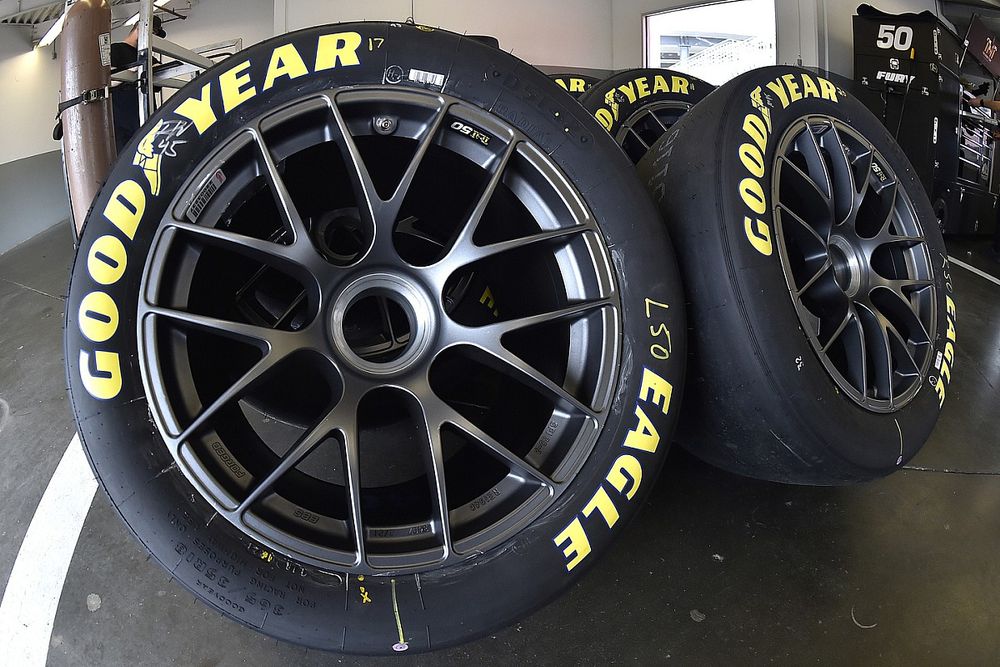For reasons that have never fully been explained, a horsepower increase is just not an option to fix what ails NASCAR’s seventh-generation Cup Series car and the sanctioning body is all-in on solving this problem through various tire experiments.
Wowed by the results of the spring race at Bristol, one in which a tremendous amount of tire falloff and speed disparity created a record number of passes, NASCAR is instead choosing to pursue compound changes instead of more aerodynamic tweaks.
There is the ongoing option tire experiment that began with the All-Star Race at North Wilkesboro, which did not immediately produce the hoped-for results due to a freshly paved surface and cooler nighttime conditions but they are trying again next month in the points-paying race at abrasive Richmond Raceway.
But there remains fears that either the option tire will either be not fast enough to create a meaningful difference or will have such a degree of fall-off to make the tire not viable over a lengthy green flag run. This is to say it remains an open question if this will ever work.
Joe Gibbs Racing No. 11 crew chief Chris Gabehart has been steadfast in his advocacy for NASCAR to either increase horsepower or narrow the width of the current tire compound, because this car just makes too much grip.
Too much grip means it’s easier to drive and that it creates less opportunity for speed disparity and passing opportunities.
“In my view what we’ve got to do is we got to make it harder,” Gabehart told Kevin Harvick on his Happy Hours YouTube show last month. “I think whether it’s more horsepower, smaller footprint on the tires which I think we could do by the way. All of the revisions that we’ve made to this car, how big a deal would it be to make a two-inch narrow wheel from the inside and make the footprint on the tire smaller.
“We simply have a horsepower grip ratio imbalance. Knocked out 100 horsepower. We went to a wider tire, went to independent rear suspension, we increased grip, decreased horsepower. That’s too easy for you. That’s too easy for the race teams. And therefore, the physics disadvantage from however you line up on the track given the scenario, is harder to overcome.”
Cliff Daniels echoed that sentiment when asked in Chicago about what NASCAR planned to do at Richmond.
“Chris Gabehart, in my opinion, has articulated this very well, where the cars are just overly-gripped and under-powered,” Daniels said. “So how do you solve that?
“Certainly, adding a higher grip tire with some fall-off is an interesting way to do it. But at the end of the day, if we had less of a tire footprint to work with or a higher horsepower footprint (which will) get us over the limit of the tire to where right now, we’re not.”
The hope is that the option tire is directionally positive, but what if it isn’t? Is there an appetite to do what Gabehart and Daniels have suggested?
Brad Keselowski also said what Gabehart expressed back in the spring before the Bristol race.
“The car takes considerably less discipline to drive,” Keselowski said. “That’s probably the biggest frustration, especially for drivers who raced in this series 10 years ago. We remember coming to tracks like Bristol, or my goodness, Martinsville, where you could never go full throttle. It took a really disciplined approach to how you drove the car and everything around it.”
So is Keselowski, who also co-owns a Cup Series team with Jack Roush and the Fenway Sports Group open to the costs associated with new wheels?
“Yeah, why not,” he said. “The engineering challenge is probably beyond my ability to solve. I’m certainly open to it.”
Why, because this car makes too much grip.
“Yeah, it connects back to the discipline required to drive the car, which is a factor of the grip level of the car and that’s power versus tire,” Keselowski said. “So this is just changing the equation. You can achieve this one of two ways, increase the power or decrease grip through the tire and the surface patch.”
Meanwhile, that same weekend, Denny Hamlin, co-owner of 23XI Racing with Michael Jordan, says he did not want to incur the cost and was still an advocate for a horsepower increase.
“I do not want to do that,” Hamlin said. “Yeah, cost, and then you have to redevelop the tire again and we have to do tire testing. I would not want to do that from an ownership standpoint for sure.”
So, what does NASCAR senior vice president of competition Elton Sawyer think? Sportsnaut posed the question on Tuesday during a media session at NASCAR Productions in Concord, North Carolina.
“I would say that nothing is off the table,” Sawyer said. “We have been consistent in our messaging about our short track package. We’ve concluded that this tire is going to move the needle quicker than anything else and be the most efficient way to get there.
“There’s obviously more that goes into that than just the tire. There’s the wheel. We think, with the way we’re working with Goodyear, that doing it through the compound is going to be the most efficient way for all.”
Keep in mind that this is the final year of NASCAR’s current agreement with all its single source supplier partners, including wheel manufacturer BBS.
If there was any chance to make a change to the wheels needed to have these tires, this would be the year but teams, the league and the manufacturer would have to agree to it.
Matt Weaver is a Motorsports Insider for Sportsnaut. Follow him on Twitter.

